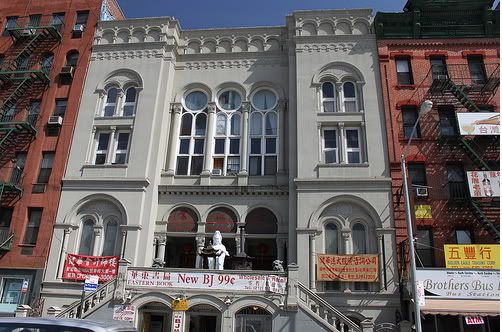an excerpt From the 1997 NYCLPC Landmark Designation Report
The Pike Street Synagogue, constructed in 1903-04 for the Congregation Sons of Israel Kalwarie, is a rare surviving synagogue building from that period of New York's history when the Lower East Side served as America's main portal for millions of Jewish immigrants. Designed by the architect Alfred E. Badt, this limestone-fronted building with its twin, lateral staircases up to the porticoed main entrance, and double stair towers projecting from the main facade creates an imposing presence on the crowded street. The basic form and massing of the building followed a stylistic precedent deriving from the Romanesque Revival and the German
At the same time, the architect included details which relate to the general classicizing tendencies in American architecture of the turn of the century. When constructed, this synagogue was one of the largest on the Lower East Side, and one of the few built specifically for this purpose. The Congregation Sons of Israel Kalwarie, started in 1853, continued to worship in this building until the 1980s. The building stood vacant for several years, but recently has been rehabilitated for a variety of uses with a Buddhist temple on the main level, apartments above, and commercial space on the ground floor.
The Jewish Community in New York
The first Jews arrived in the Dutch colony of Nieuw Amsterdam in 1654, coming from Brazil in an unsuccessful attempt to reach Holland. Although the Jews were allowed to stay in the colony, they gained political as well as religious rights only when the British took control in 1664. Around 1682, the first Jewish congregation in New York was established: Congregation Shearith Israel or Remnant of Israel. It was not until 1729 that the congregation constructed its first synagogue building, a small structure on Mill Street (now William Street) which served until 1818, when it was replaced with a larger one.
Between 1815 and 1825 the Jewish population of New York swelled to 500, with immigrants coming mostly from Europe primarily because of the fall of Napoleon. In 1825 a group of German and Polish Jews broke away from Congregation Shearith Israel to farm their own synagogue, Congregation B 'nai Jeshrun. This was the beginning of a trend, as numerous other congregations were then created out of existing groups because of political differences, different interpretations of religious law and customs, or simply because of the desire to worship with fellow countrymen using common rituals.
By 1860 there were approximately 27 synagogues in New York City, most of which resulted from divisions within existing synagogues. This growth in the number of congregations was supported by, but not wholly attributable to, the increasing Jewish population which rose to 10,000 in 1846 and then to 60,000 in 1880.
During the early eighteenth century, most of New York's Jews lived close together downtown, indicated by the fact that Shearith Israel built, and then rebuilt its synagogue on Mill Street. Typically, immigrants of common backgrounds often chose to live near each other in an effort to provide mutual support in their new land. As they became more comfortable in their new home and achieved more financial success, they were often willing to move away from the original group.
Thus by the 1820s, the area of Broadway, Laight, Charlton, Greene, and Wooster Streets began attracting some wealthier Jews. By the 1830 s and 1840s the area around Bayard, Baxter, Mott, and Chatham Streets was home to many Dutch, German, and Polish Jews, while Chrystie, Market, Henry, and Division Streets began to attract many other new Jewish immigrants and became the nucleus of what came to be known as the Jewish Lower East Side.
As this neighborhood became more densely populated, synagogue congregations subdivided based on kinship and on countries and towns of origin, each group supporting its own synagogue.



























No comments:
Post a Comment